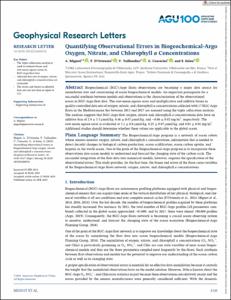| dc.contributor.author | Mignot, A. | |
| dc.contributor.author | D'Ortenzio, F. | |
| dc.contributor.author | Taillandier, V. | |
| dc.contributor.author | Cossarini, G. | |
| dc.contributor.author | Salon, S. | |
| dc.date.accessioned | 2023-03-02T20:00:52Z | |
| dc.date.available | 2023-03-02T20:00:52Z | |
| dc.date.issued | 2019 | |
| dc.identifier.citation | Mignot, A., D'Ortenzio, F., Taillandier,V., Cossarini, G. and Salon, S. (2019) Quantifying observational errors in
Biogeochemical‐Argo oxygen, nitrate,and chlorophyll a concentrations. Geophysical Research Letters, 46, pp.4330–4337. DOI: https://doi.org/10.1029/2018GL080541 | en_US |
| dc.identifier.uri | https://repository.oceanbestpractices.org/handle/11329/2148 | |
| dc.description.abstract | Biogeochemical (BGC)‐Argo floats observations are becoming a major data source for
assimilation into and constraining of ocean biogeochemical models. An important prerequisite for a
successful synthesis between models and observations is the characterization of the observational
errors in BGC‐Argo float data. The root‐mean‐square error and multiplicative and additive biases in
quality‐controlled data sets of oxygen, nitrate, and chlorophyll a concentrations collected with 17 BGC‐Argo
floats in the Mediterranean Sea between 2013 and 2017 are assessed using the triple collocation analysis.
The analysis suggests that BGC‐Argo float oxygen, nitrate and chlorophyll a concentrations data have an
additive bias of 2.9 ± 5.5 μmol/kg, 0.46 ± 0.07 μmol/kg, and −0.06 ± 0.02 mg/m3, respectively. The
root‐mean‐square error is evaluated at 5.1 ± 0.8 μmol/kg, 0.25 ± 0.07 μmol/kg, and 0.03 ± 0.01 mg/m3.
Additional studies should determine whether these values are applicable to the global ocean.
Plain Language Summary The Biogeochemical‐Argo program is a network of ocean robots
whose sensors monitor oxygen, nitrate, and chlorophyll a concentrations, information that is needed to
detect decadal changes in biological carbon production, ocean acidification, ocean carbon uptake, and
hypoxia in the world ocean. One of the goals of the Biogeochemical‐Argo program is to incorporate these
observations into ocean models to understand and forecast the changing state of the carbon cycle. The
successful integration of the float data into numerical models, however, requires the specification of the
observational errors. This study provides, for the first time, the biases and errors of the three cores variables
of the Biogeochemical‐Argo floats network: oxygen, nitrate, and chlorophyll a concentrations. | en_US |
| dc.language.iso | en | en_US |
| dc.rights | Attribution 4.0 International | * |
| dc.rights.uri | http://creativecommons.org/licenses/by/4.0/ | * |
| dc.subject.other | Chlorophyll a | en_US |
| dc.subject.other | BGC-Argo | en_US |
| dc.subject.other | ARGO floats | en_US |
| dc.title | Quantifying observational errors in Biogeochemical‐Argo oxygen, nitrate, and chlorophyll a concentrations. | en_US |
| dc.type | Journal Contribution | en_US |
| dc.description.notes | https://agupubs.onlinelibrary.wiley.com/journal/19448007 - all articles are open access in GRL as of 1 Jan 2023. | |
| dc.description.refereed | Refereed | en_US |
| dc.format.pagerange | pp.4330–4337. | en_US |
| dc.identifier.doi | https://doi.org/10.1029/ 2018GL080541 | |
| dc.subject.parameterDiscipline | Nutrients | en_US |
| dc.subject.instrumentType | Biological and biogeochemical models | en_US |
| dc.subject.dmProcesses | Data processing | en_US |
| dc.bibliographicCitation.title | Geophysical Research Letters | en_US |
| dc.bibliographicCitation.volume | 46 | en_US |
| dc.description.sdg | 14.a | en_US |
| dc.description.eov | Oxygen | en_US |
| dc.description.eov | Nutrients | en_US |
| dc.description.maturitylevel | Pilot or Demonstrated | en_US |
| dc.description.adoption | Novel (no adoption outside originators) | en_US |
| dc.description.methodologyType | Method | en_US |
| obps.contact.contactname | A. Mignot | |
| obps.contact.contactemail | mignot@mercator‐ocean.fr | |
| obps.resourceurl.publisher | https://agupubs.onlinelibrary.wiley.com/doi/10.1029/2018GL080541 | |
 Repository of community practices in Ocean Research, Applications and Data/Information Management
Repository of community practices in Ocean Research, Applications and Data/Information Management

